
What does our Galaxy look like?
We live in the Milky Way Galaxy, which is a collection of stars, gas, dust, and a supermassive black hole at its very center. Our Galaxy is a spiral galaxy, which are rotating structures that are flat (disk-like) like a DVD when looked upon edge-on.
There is also a bulge in the middle that consists of mostly old stars. When you look at a spiral galaxy face-on, you can see beautiful spiral arms where stars are being born. Our solar system is in the Orion arm, and we are about 25,000 light years (2.5 X 10^17 miles) from the very center of the Galaxy.
Since our solar system lies in one of the spiral arms, we live in the flat plane of the Milky Way. We can actually see the dense plane of the Milky Way stretch across the sky in dark places that do not have a lot of surrounding light pollution.
The diffuse light is the combined light from millions of stars. Some of the light from these stars are obscured by large clouds of dust, which is why there are dark patches. Dust and gas are necessary to form stars, and most stars are formed within the spiral arms.
Note that we can't really see the center of the galaxy with our eyes because there is dust in the way!
Center of the Milky Way
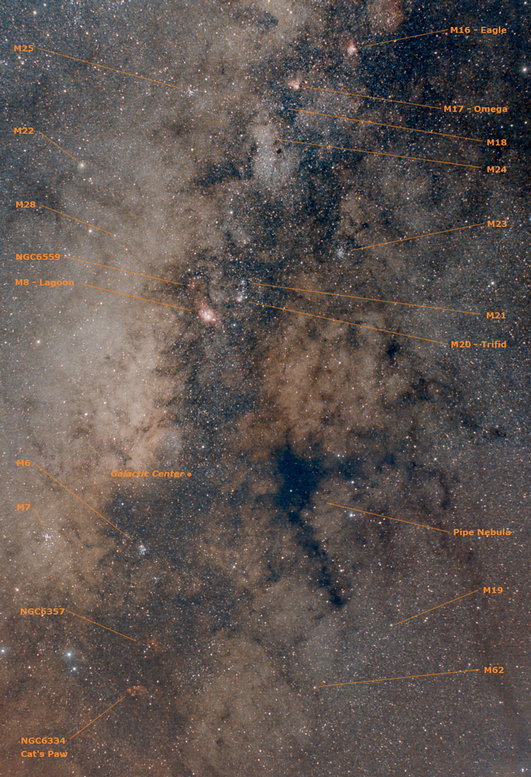
The very center of the Milky Way is known as the Galactic Center. It has a unique collection of very exotic objects that have intrigued astronomers for many decades.
Some examples include a quiescent supermassive black hole, a collection of wispy magnetic filaments, a few dense stellar superclusters which host mysterious and massive stars, and a family of gas streamers spiraling toward a central dark mass.
One problem we saw earlier was that we can't look at the Galactic Center in visible light (the light that our eyes can see) because there is dust in the way.
In order to study the Galactic center, we need to look at it at different wavelengths of light that our eyes are not sensitive to. This can also help us uncover what is happening at this very exciting part of our Galaxy.
Along with the young star clusters in the immediate vicinity of the Galactic Center, these clusters provide an ideal opportunity to study how stars and clusters form under extreme initial conditions.
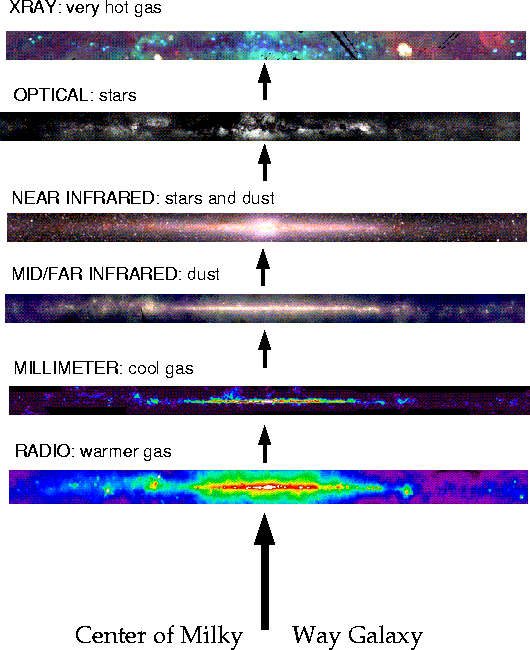
Light and wavelengths: The Galactic Center at different wavelengths
As you can see from these images, while the optical light is dark, the radio, sub-millimeter, mid-infrared, near-infrared, and X-ray light can all penetrate through the dust.
Different kinds of telescopes are necessary to take data at these different wavelengths. The quality of the data one gets from a telescope is often measured by the resolution of the telescope. This is proportional to the wavelength the data is taken at divided by the diameter of the telescope (Resolution ~ Wavelength/Diameter).
For instance, in order to obtain high-resolution images at radio (long) wavelengths, we must use an array of telescopes that have a long effective baseline, but can be broken up into smaller telescopes.
One example of this is the Very Large Array (VLA) in Soccoro, New Mexico. However, high resolution infrared and optical images are being produced with telescopes containing a single 10 meter mirror diameter, such as the twin Keck telescopes in Mauna Kea in Hawaii.
Let's take a look at some high-resolution images of the Galactic Center at various wavelengths.

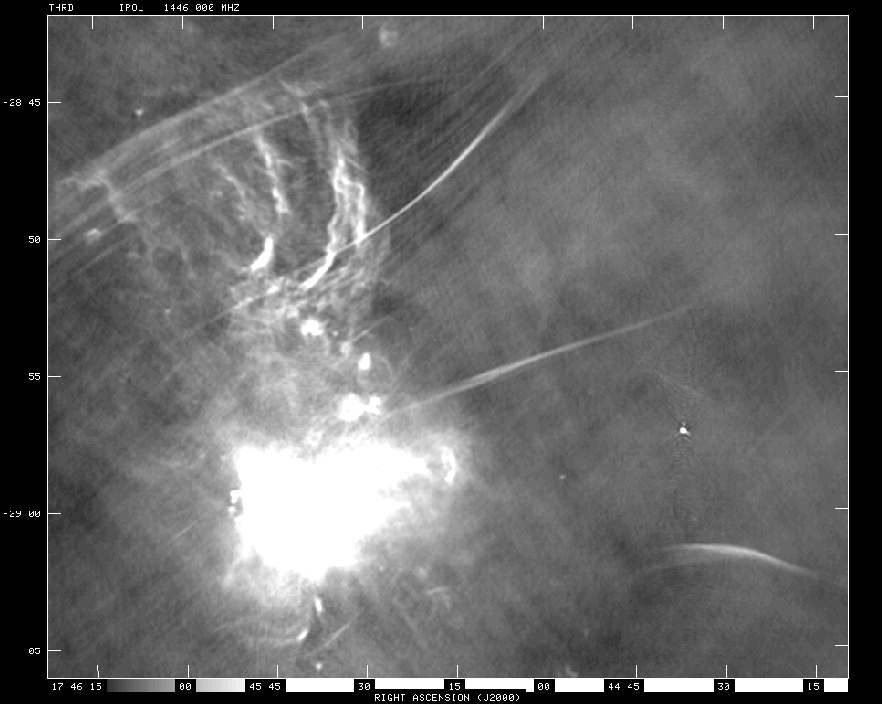
Radio
The Galactic Center was first detected in 1932 at radio wavelengths by the pioneer of radio astronomy, Karl Jansky. However, at that point in time, radio astronomy was largely done with a single large dish-like telescope, not arrays like the VLA.
These large dishes could just detect a strong radio source toward the Galactic Center and not mch else. Since then, some of the most striking images of the Galactic Center have been produced by the VLA.
The image at the far left shows an example of Galactic Center radio data. The two most prominent features are the non-thermal and thermal radio arcs or "filaments" and a collection of ring-shaped supernova remnants (SNRs).
The brightest part is towards he Galactic Center. Note that the wavelength of these observations are 90 centimeters. The wavelength of light coming from these observations is about 1.8 million times longer than the wavelengths of light our eyes can see!
The whispy radio filaments that are visible in the near left image were first imaged by UCLA Astronomy Professor Mark Morris and his colleague Farhad Yusef-Zadeh in the mid 1980s. These unique structures have only been observed toward the Galactic Center and are very strongly magnetized.
The emission coming from these filaments happens as a result of charged particules spiraling at relativistic speeds around magnetic field lines.
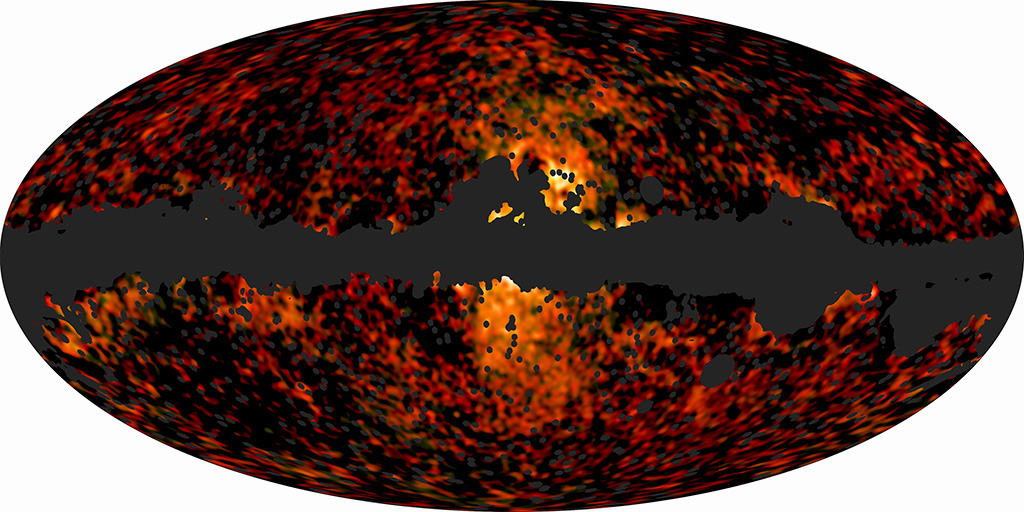
Microwave and Sub-Millimeter
Microwave data shows emission from cool gas and dust. The image at left shows recent results from Planck, the European Space Agency's (ESA) recent microwave space-based mission. Since Earth's atmosphere absorbs microwaves so efficiently, all observations at this wavelength must be done in outer space with satellites (like COBE and Planck). These results show previously unknown groups of cold gas and a "haze" of microwaves. This is really important because the wavelength that this image is taken at traces carbon monoxide (CO). CO is a cold molecule that is easily detectable and traces molecular hydrogen (two hydrogen atoms bound together), which is required for stars to form. The "haze" could come from synchrotron emission.
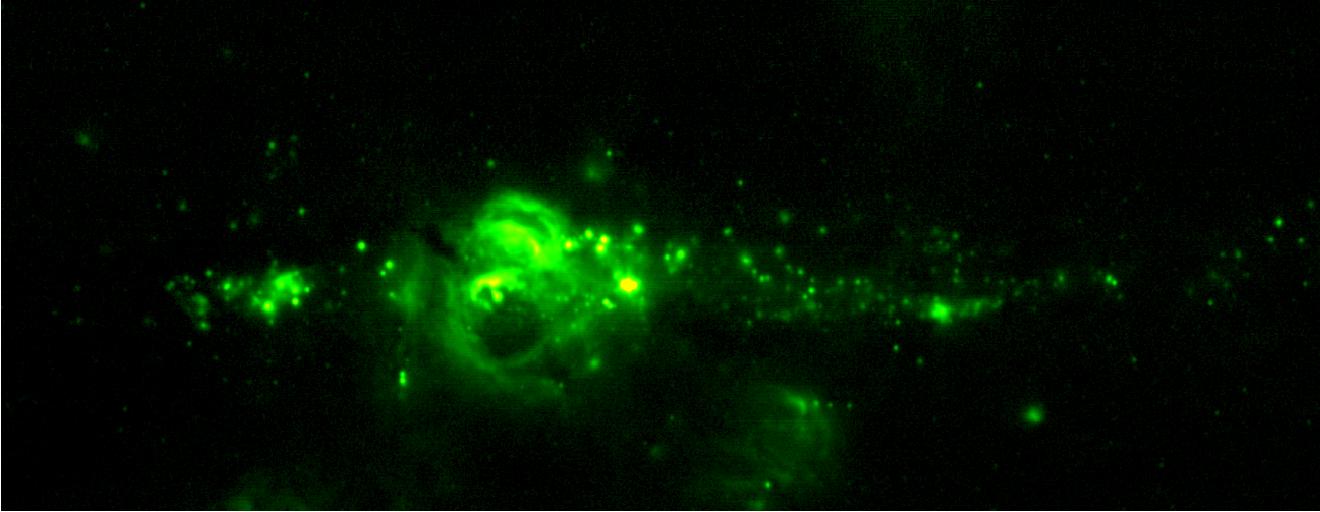
Mid-Infrared
The mid-infrared wavelengths trace cold objects and are incredibly efficient in cutting through the dust that obscures our view to the Galactic Center. In this Chandra mid-image, we are able to see cold dust, dust-covered stars, faint stars, and dense arcs of dust.
To observe in the mid-infrared, however, astronomers have to either send satellites into space or observe in the stratosphere, like the SOFIA observatory.
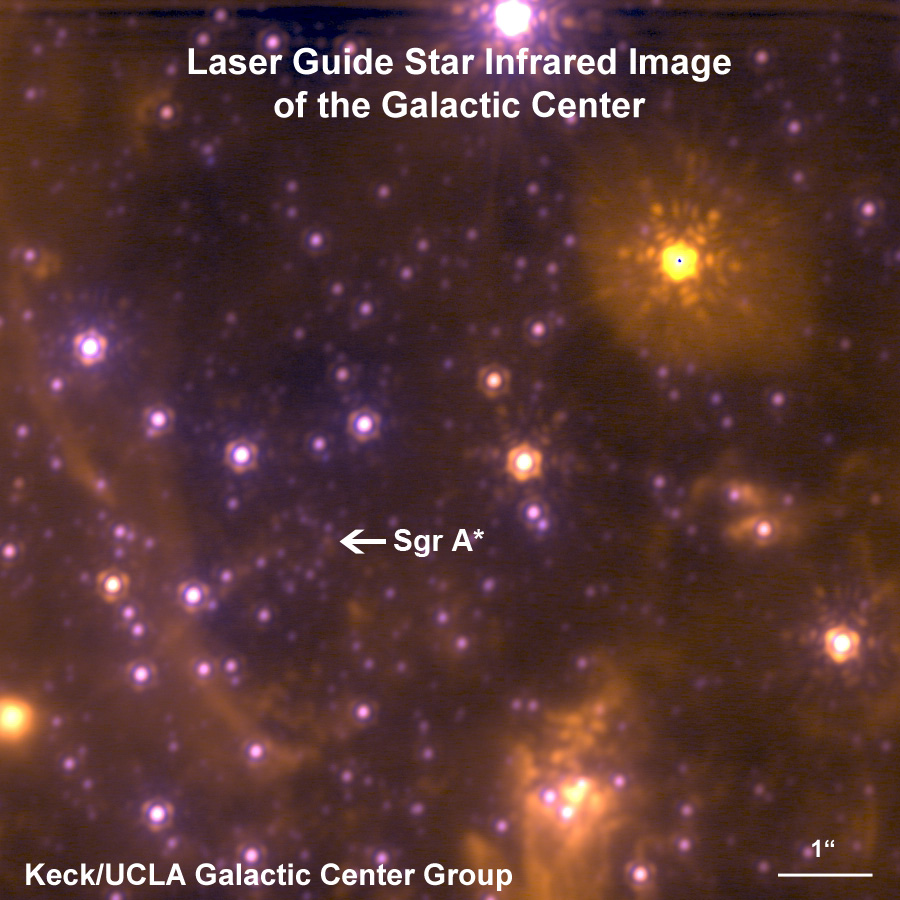
Near-Infrared
Near-infrared wavelengths are a very popular region of the electromagnetic spectrum for observing the Galactic Center due to both their ability to pass through the dust along the plane as well as our ability to get high angular resolution images at these wavelengths.
Also, near-infrared detectors (which are the near-infrared version of the CCDs that are in cameras) are progressively getting better.
Near-infrared images of the Galactic Center probe the stellar content showing an abundant amount of stars. The earliest near-infrared images of the Galactic Center could only resolve groups of stars, while recent observations (like those taken in the Galactic Center Group at UCLA) c ould only resolve groups of stars.
In fact, high angular resolution near-infrared images by the Keck telescope have been able to resolve a tiny cluster of stars orbiting the supermassive blackhole at the very center of our Galaxy. We have also been able to obtain spectra of the stars.
This means that we take the near-infrared light and separate it by wavelength. This allows us to determine what kinds of stars exist in the Galactic Center, and we have found blue supergiants, red giant stars, dust obscured stars, and so on.
With bigger telescopes on the way (like the Thirty Meter Telescope), there is much more near-infrared research ahead!
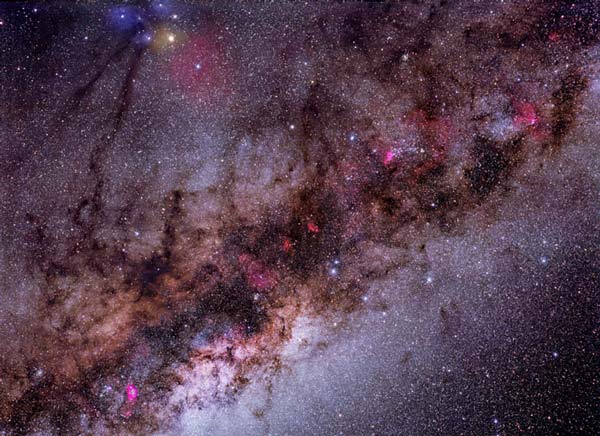
Optical
It is nearly impossible to observe anything at the Galactic Center at optical wavelengths.
While our telescopes to have the resolution to do so, the large amount of starlight-obscuring dust along the plane of the Galaxy causes any optical light from the Galactic Center to be extincted by 30 orders of magnitude (1 X 10^30).
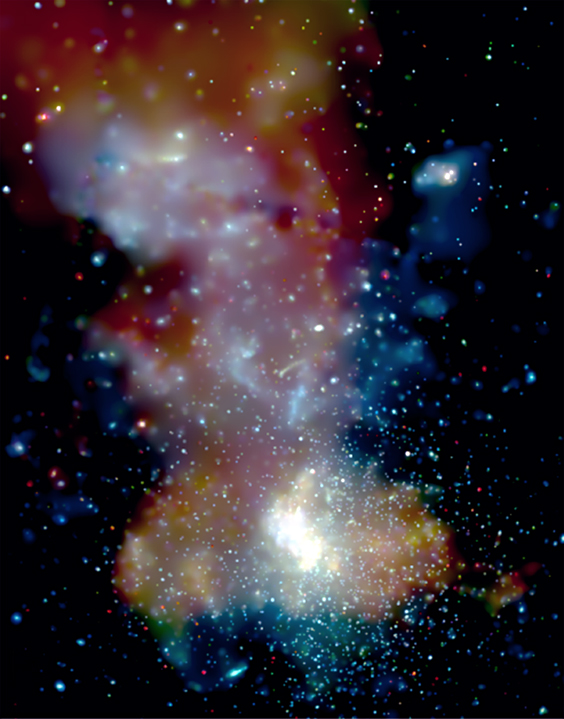
X-ray
The image to the left shows X-ray emission from the Galactic Center taken with the Chandra X-Ray observatory.
The points of light seen in this image show hot white dwarfs, neutron stars, and black holes, all swimming in a hot gas many millions of degrees. The brightest patch in the center is the supermassive black hole.
Star clusters are also visible that host massive, x-ray emitting stars.The gas here glows in X-ray light because it has been heated to a temperature of millions of degrees by shock waves produced by supernova explosions and perhaps by colliding winds from young massive stars. The Galactic Center is truly an energetic region.
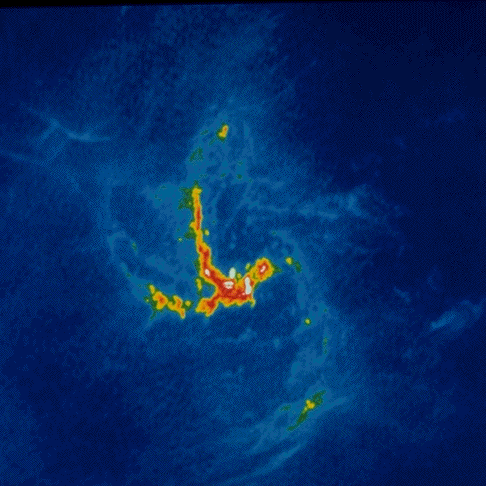
What is happening to the gas in the Galactic Center?
As we saw before, we can trace ionized gas at radio wavelengths. High-resolution observations of the Galactic Center at radio wavelengths have revealed a structure called the "mini-spiral." The mini-spiral has several different parts--the Northern Arm, the Wester Arc, and the Eastern Arm.
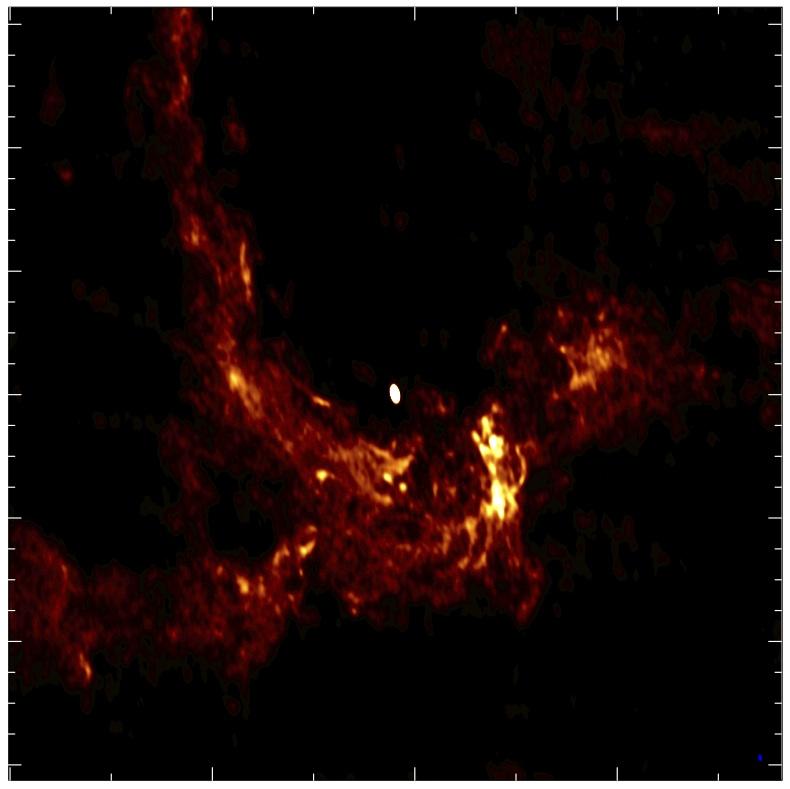
Motion of the gas
The motion of the gas in the mini-spiral can be determined using the Doppler shift of emission lines, particularly Ne II and Bracket-gamma hydrogen lines.
These studies show that the gas along the Northern Arm is falling in toward, or obriting around, the central black hole. Current evidence suggests that the three arms are orbiting the supermassive black hole according to Kepler's laws, and that the gas in the Northern Arm is actually interacting with a nearby source.
The Eastern Arm is actually colliding with the Northern arm flow, and that the gas is photoionized--electrons are being stripped off (Zhao et al 2009).

The Circumnuclear Disk (CND)
In addition to having different arcs and arms, the mini-spiral is surrounded by a thick ring of molecular material called the Circumnuclear Disk (CND).
The origin of this disk is unclear, but it is a ring, or a torus, with an inner radius of about 1 parsec and an outer radius of several parsecs (Note: 1 parsec is 1.917 X 10^13 miles!).
This disk's rotation follows Kepler's laws, and it is heated by both central region of old stars and the ultraviolet (short wavelength) flux of bright young stars that are near the black hole.
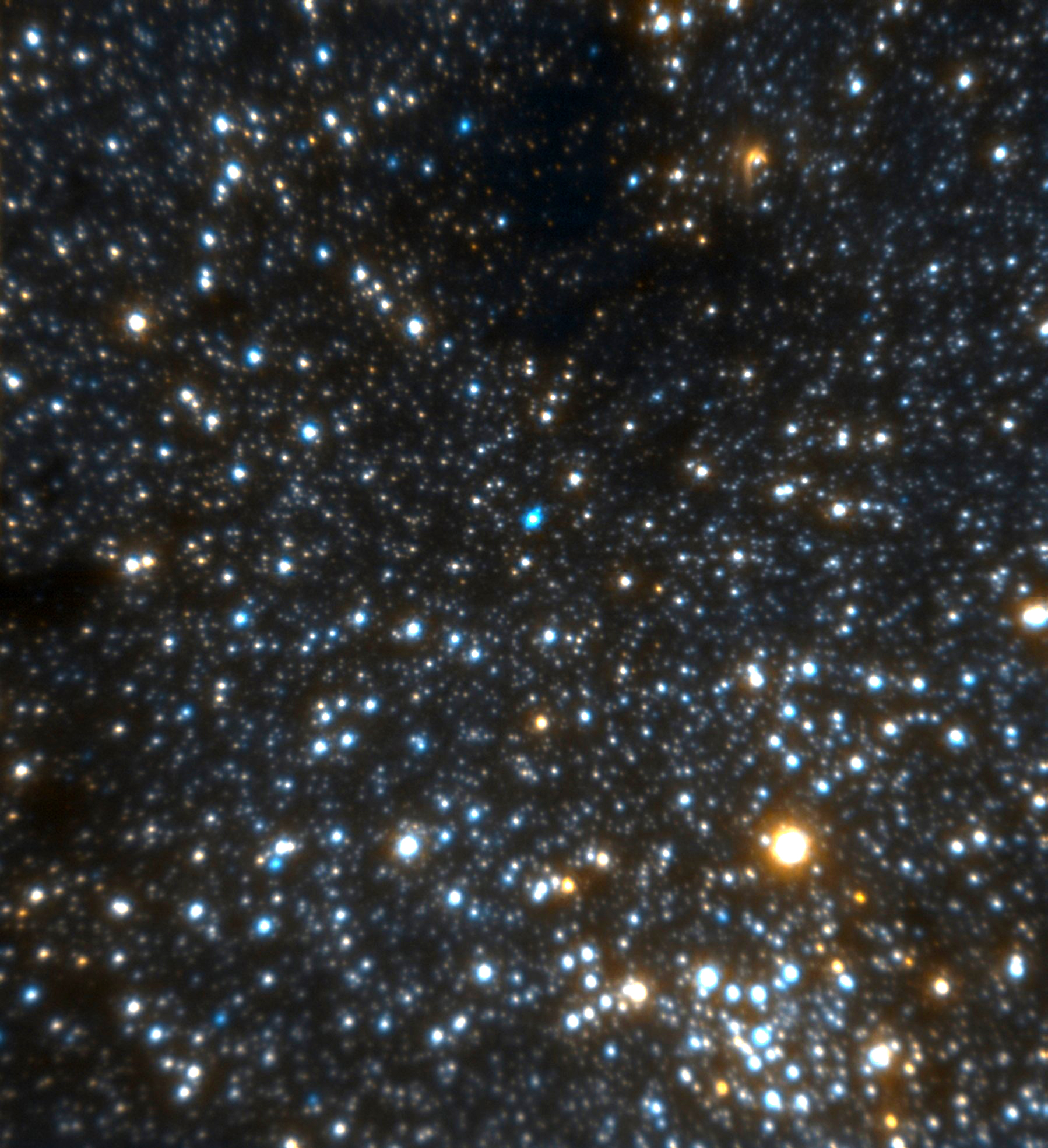
What sort of stars are at the Galactic Center?
High resolution near-infrared imaging has led to the discovery of three stellar superclusters at the Galactic Center. Since near-infrared wavelengths cut through the dense dust between Earth and the Galactic Center, we are able to see these superclusters.
They include the Central Parsec, Quintuplet, and Arches clusters.
The Arches cluster is a densely packed star cluster, which is surprising due to it's closeness to the supermassive black hole at the center of our Galaxy.
Since black holes have a strong gravitational field, they affect the area around them with tidal forces. The Arches cluster's proximity should cause the cluster to be torn apart. The fact that it is still around means that it is probably a young cluster.
Members of the Galactic Center Group at UCLA discovered circumstellar disks in the Arches Cluster (the presence of a circumstellar disk means that a star is really young, and it is in the process of forming), which supports the hypothesis that this cluster is very young (Stolte et al. 2010).
The Quintuplet Cluster is named after the five red stars in the image to the left. These particular stars do not have any observable emission or absorption lines in their stellar spectra, which has kept their identity a mystery.
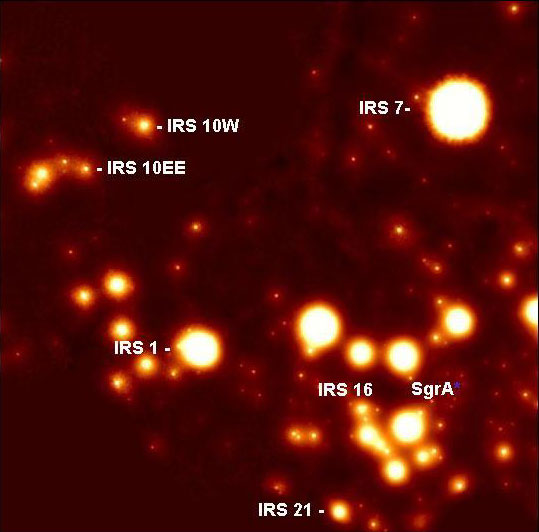
The Quintuplet cluster
In addition to the young stars found in the Arches cluster and the peculiar stars found in the Quintuplet cluster, there is a large number of late-type (not very massive and fairly cold, spectral type K and M) stars at the Galactic Center.
These were discovered by looking for CO absorption bands in their stellar spectra. These are therefore cold stars, and they look red in the top Gemini image (red colors mean that the object is cool, while blue and white objects are hot).
The brightest star in the Gemini image is known as IRS 7, and it is an M supergiant. Most of the late-type stars are giants, supergiants, or more evolved giant stars called AGB, OH-IR, and Mira viarable stars.
The M and K sueprgiants were formed 3 - 7 million years ago, while the AGB stars are about 100 million years old. There is a lack of late-type stars in the central 10 arcseconds of the Galaxy, close to the supermassive black hole.
Astronomers are trying to determine why this is the case, and where the young, early-type stars that exist there came from--if they were formed in the Galactic Center or if they were formed somewhere else and moved to the center of our Galaxy.
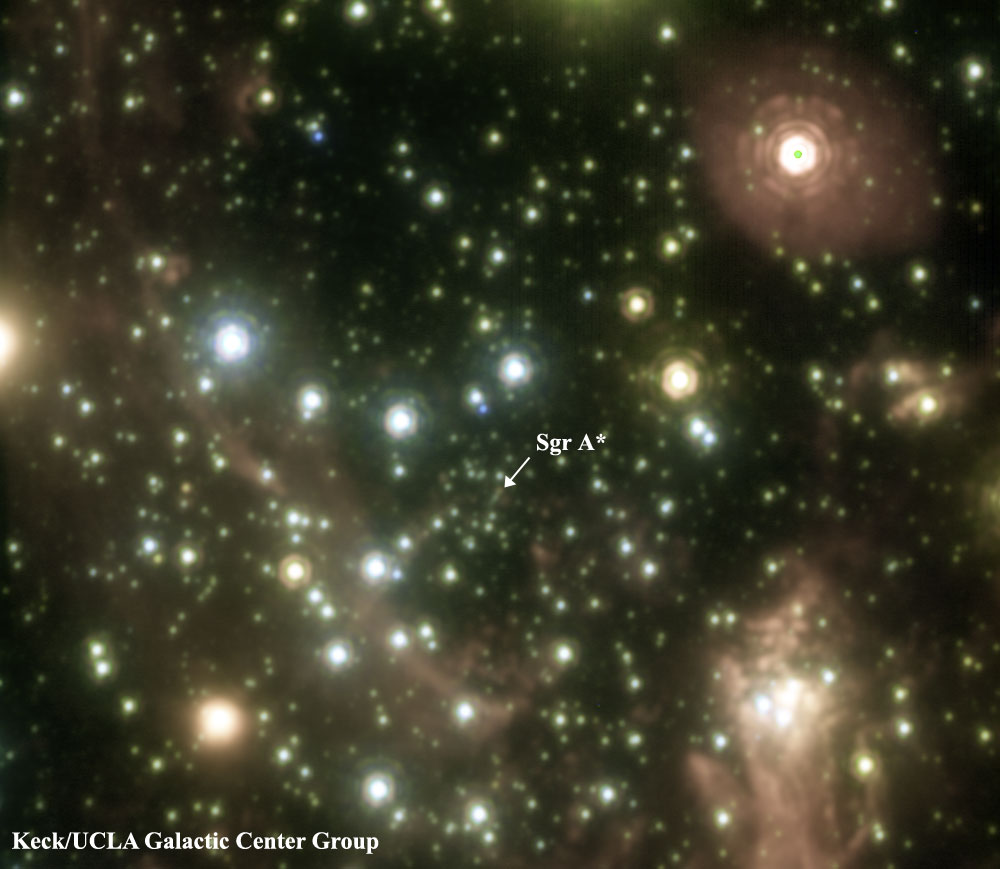
The young, massive stars
The young, massive, early-type (O, A, and B spectral class) stars are the brightest stars in the Galactic Center and contribute most of the ultraviolet radiation that ionizes the surrounding gas seen in the mini-spiral. These stars have Helium (He I) and Hydrogen (H I) emission lines in their spectra, which are come from the fast winds flowing away from the stars.
The most noticeable cluster of these stars are in the IRS 16 cluster, which are located close to Sgr A*. T hese stars are also 3 - 7 million years old. The Galactic Center tends to host, on average, more massive stars than other clusters found in the local neighborhood.
This is probably due to the extreme conditions found at the Galactic Center created by the supermassive black hole, the large magnetic field, and the UV radiation from early-type stars.
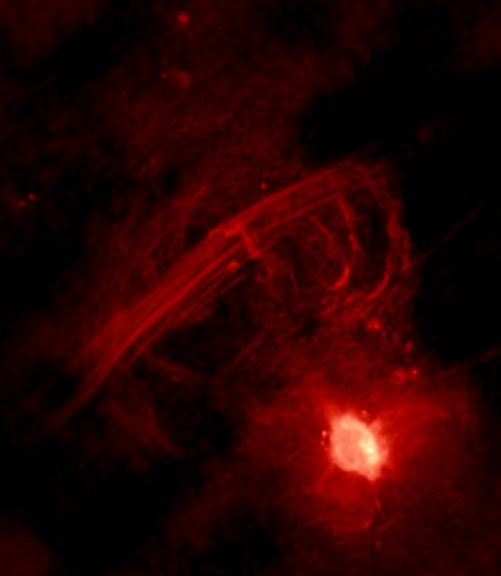
Our supermassive black hole: is there a black hole at the center of the Galaxy?
As we zoom into the very core of the Galactic Center, our field of view shrinks to a mere 5 arcseconds (one thousandth of a degree). At radio wavelengths, the brightest feature of this region is the point-like radio source Sagittarius A* (pronounced "Sag A star").
This source is a compact object, and approximately one Astronomical Unit (1 AU is about 93 million miles) in size, which is much smaller than our solar system (Neptune is 2.8 billion miles from the Sun). At near-infrared wavelengths, this point source in the radio is not clearly seen.
Astronomers have seen pulsation near the radio position of Sgr A* in the near-infrared, which they attribute to this radio source flaring.
In 1974, Sir Martin Rees proposed the idea that supermassive black holes could exist within the centers of active galactic nuclei or quasars. In that same year, Balick and Brown made the conenction between their radio detection of Sgr A* and other known active galactic nuclei.
In the past 20 years, astronomers have collected enough evidence through the observed motions of gas and stars to convince ourselves that something very massive lurks at the center of our galaxy.
The first dynamical evidence came from the motions of the ionized gas streamers of the mini-spiral orbiting Sgr A*. Using the velocities of the gas estimated from the Doppler shift of spectral lines, astronomers estimated that a mass of six million solar masses must lie within 10 arcseconds of Sgr A*.
This did not explicitly prove the existence of a black hole since that amount of matter could be accounted for by a high density of stars within such a large volume.
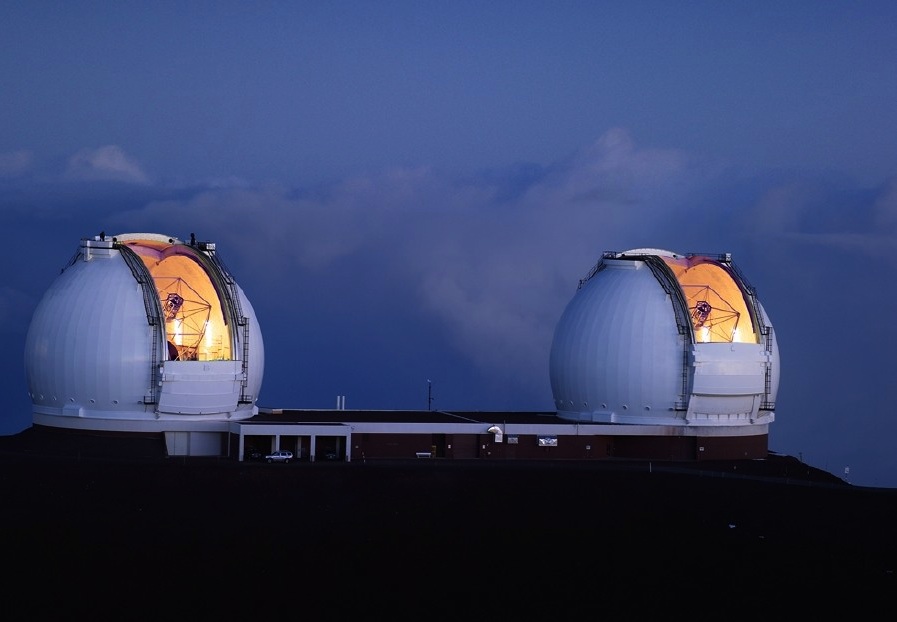
The Groups studying the Galacic Center
Since 1995, high-resolution near-infrared studies have observed a compact cluster of early-type stars surrounding the radio position of Sgr A*. These stars have very large proper motions (they are moving across the sky very quickly) considering their 24 million light year distance from the Earth.
The two main groups devoted to tracking these stars include Andrea Ghez and others at UCLA, who use the 10-m Keck telescope on Mauna Kea, Hawaii, and Reinhard Genzel and Andreas Eckart who use the 8-m VLT telescopes in Chile.
Both groups take advantage of the high spatial resolution and sensitivity of these large telescopes to track the positions of the stars within the cluster using near-infrared images collected once or twice a year.
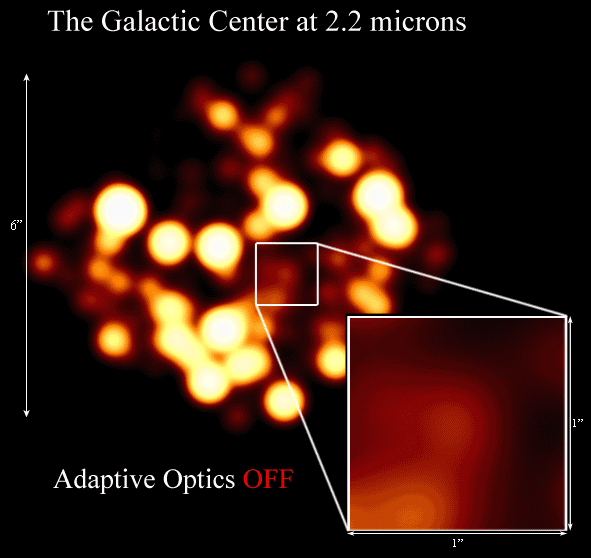
Adaptive Optics
Despite the large diameters of the Keck and VLT telescopes, air turbulence in the Earth's atmosphere blurs the images taken at the telescopes.
The atmosphere has a lot of molecules that are colliding into each other and getting heated up. On really hot days, we can see the heat waves coming up off the ground, or if you look at a flame, you can see the heat influencing the air around it.
This is what happens in our atmosphere. In order to correct for it, astronmers are now using Adaptive Optics (AO) systems, which increases the sensitivity of observations.
AO systems use a deformable mirror that mimics the shape of the incoming lightwave and corrects for the atmospheric turbulence before the data is recorded.
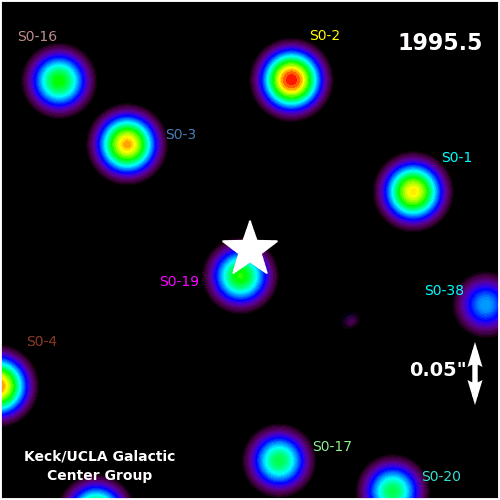
Stellar Orbits about the Black Hole
Very accurate stellar positions can be estimated in order to keep track of the motions of the stars in the compact central cluster, which are zipping around Sgr A* at speeds up to 3 million miles per hour!
Using Kepler's laws of motion, the orbital velocities and the positions of the bright stars an be used to estimate the mass that must be contained within their orbits.
The resulting enclosed mass is 4.6 ± 0.7 X 10^6 solar masses--4.6 million times the mass of our Sun!
This large mass combined with the minute size of Sgr A* in radio emission suggests taht the stars must be swiftly circling around a supermassive black hole.
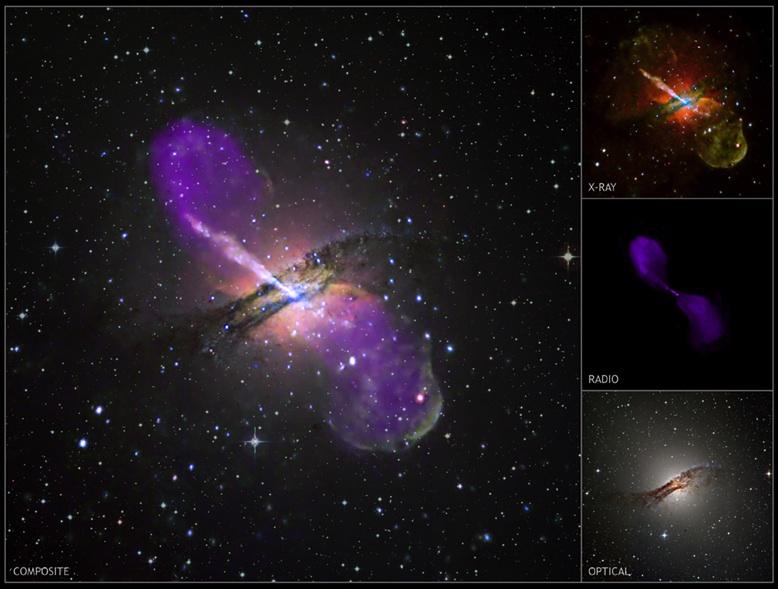
Black Holes in other Galaxies
Recent observations of nearby galaxies reveal that such supermassive black holes are not unique to the MIlky Way. The formation of such a large black hole and how it affects the evolution of its host galaxy are not well understood. In the case of Sgr A*, there is a mysterious absence of the high energy emission (X-rays and UV radiation) often observed from active galactic nuclei. The image to the left is of an active galactic nucleus in Cen A. There is a lot of activity at long wavelengths and short, energetic wavelengths. This is completely different than our galactic nucleus, Sgr A*. Sgr A* may have been more energetic in the past.
We hope you have enjoyed this Galactic Journey and now have some understanding of what's going on in the center of our Galaxy!
Thank You - The Galactic Center Group.